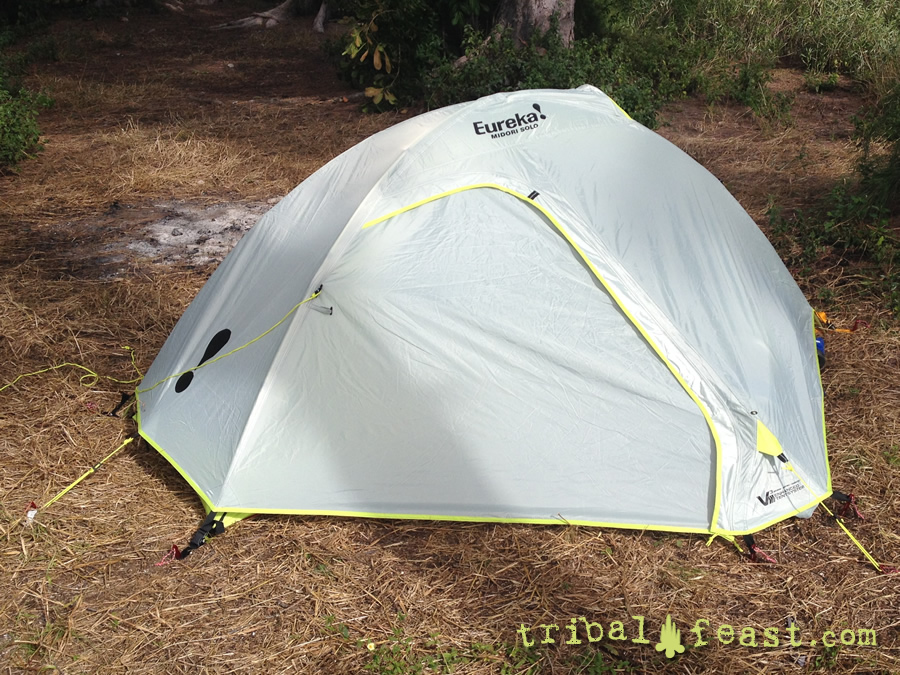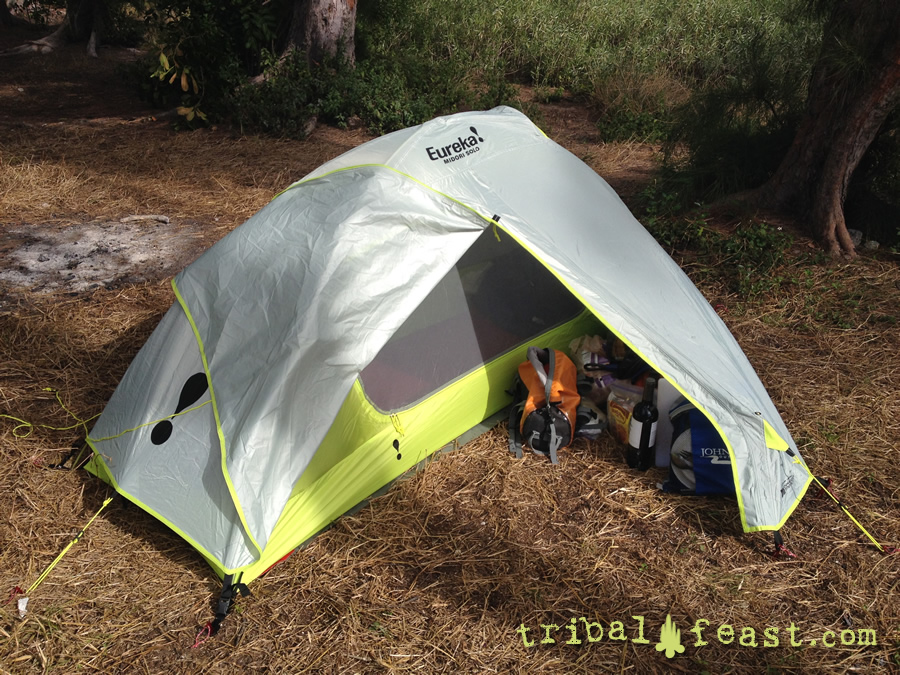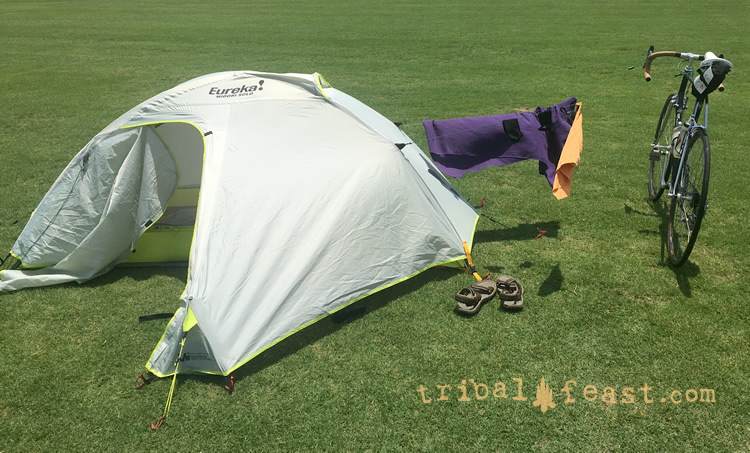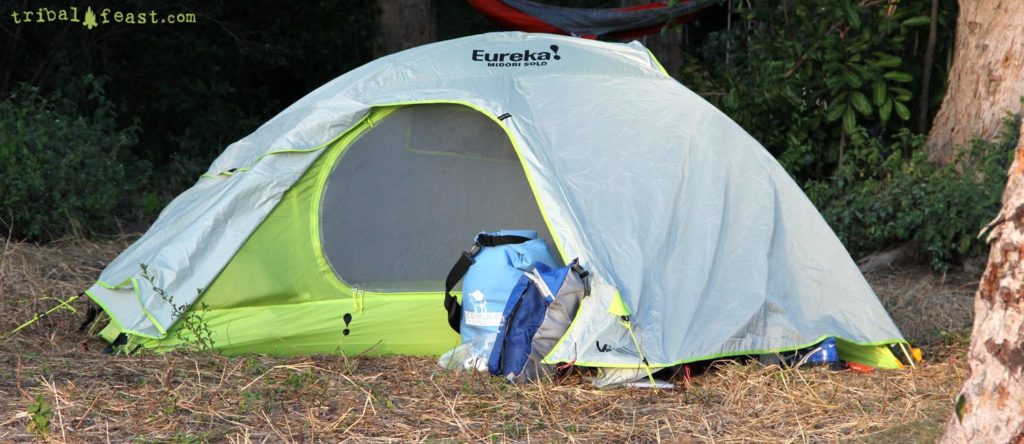Just in case anyone missed the memo, the Eureka Midori Solo is a One-Person tent.
If you’ve never seen a one-person tent up close and personal, you will probably have the same “oh shit that’s small” reaction that everyone does the first time they poke their head in the door. So be forewarned: if you bring your Midori Solo to the KOA and end up polishing off a box of wine with a new-found friend, the whole “my place or yours?” thing is a foregone conclusion.
If, however, you need an inexpensive, rugged, and compact tent for solo journeys where you will be all by your lonesome and sleeping all alone, by yourself, the Midori Solo offers a surprising amount of bang for the buck.
So the big question: is the Midori Solo a good tent option for you?

Smaller is not always cheaper
Well, if you are still reading this, you are obviously hellbent on downsizing from a two-person tent, most likely so you will have a bit more room in your pack and/or have less weight to carry. The Midori Solo would definitely fit the bill, however if light weight is the biggest consideration, you may want to consider a top-of-the-line ultralight tent like the Big Agnes Fly Creek UL or the MSR Hubba NX. You’ll find either to be considerably lighter than the Midori Solo, however you’ll find your wallet to be much lighter too.

For an affordable one-person tent, the Midori Solo is hard to beat. The floor dimensions are a bit longer than other one-person tents, which means that unless you are very tall, you will have some room at either your head or feet for a small amount of gear. There is decent headroom and I’ve never felt cramped while sitting up. Organization in such a tiny space is made all the easier with an included gear loft and two mesh pockets at either end of the tent that are perfect for stashing those go-to solo camping essentials like a magazine and box of Kleenex.
Room to spare
The vestibule is what sets the Midori Solo apart. It is huge for a tent this size and this is due to a unique design inside the vestibule that incorporates a tiny pole to lift the tent wall up a bit. You have to be conscious of the direction that little pole is sitting when packing up the tent, but it hasn’t proven to be an issue.

Keep your cool
Airflow in the tent is excellent. Having camped a lot in Florida, I am a very big fan of roof vents in tents. If the bottom of the tent vents well, the roof vent will draw air like a chimney pulling cool air in around the floor of the tent – where you are sleeping. The Midori Solo has one decent roof vent and does a great job of pulling the fly away from the inner tent around the base so that air flow isn’t restricted in this critical area. If the ground is damp, I find it cooler to zip up the fly at night even when it is stinking hot out.
Withstand the rigors
The main problem with using ultralight backpacking tents for activities like bike touring and sea kayak camping is that they lack the durability to be set up in less than ideal places. Anyone who has been on a solo trip where he or she has had to pitch a tent in the night, in a downpour, on ground full of rocks, oyster shells, and/or thorns, knows that a $500 ultralight backpacking tent can be a liability.
Sometimes you need gear that can survive harsh conditions, and in case it doesn’t, you know you won’t be forfeiting a paycheck for your misadventure. The Midori Solo shines for these more rough-and-tumble situations. And for guerrilla stealth camping, it’s just the ticket.
Staying dry
Speaking of rain, I have had the Midori Solo in some pretty severe downpours and never had any issues. It is has proven to be a more reliable tent than my other more pricey shelters. One caveat to this, however, is that there is no footprint available from the manufacturer. I improvised one from some tent material, but I would much rather have purchased one that was made for the tent.
An all around great value
Because it is so easy to set up and has such a spacious vestibule, the Eureka Midori Solo has been my tent of choice for the Bicycle Ride Across Georgia. Compact and reliable shelter that is easy to set up is pure gold on group trips like BRAG, and the Midori Solo really shines for these situations. I switched to the Midori Solo from an old two-person Marmot and was so happy to have all the extra room in my pack and thankful I wasn’t subjecting my rather delicate and expensive Big Agnes Fly Creek UL to the rigors of being repeatedly thrown off the back of a semi for a week.
Invite some friends
If all of this has you sold on the Midori, but you are still on the fence about the one person tent route, the good news is that Eureka also makes the Midori in a two-person version and, for those into a more freer lifestyle, a swinging three-person love shack!
Midori Solo Specs
One Person
Three Seasons
Floor Size: 7′ 6″ x 2′ 8″
Pack Size: 5″ x 16″
Min Weight:3 lbs. 10 oz.
Tent Area: 20 sqft
Center Height: 3′

TL;DR
-
Quality Quotient - 83%83%
-
Packability Factor - 75%75%
-
Rain Rating - 84%84%

